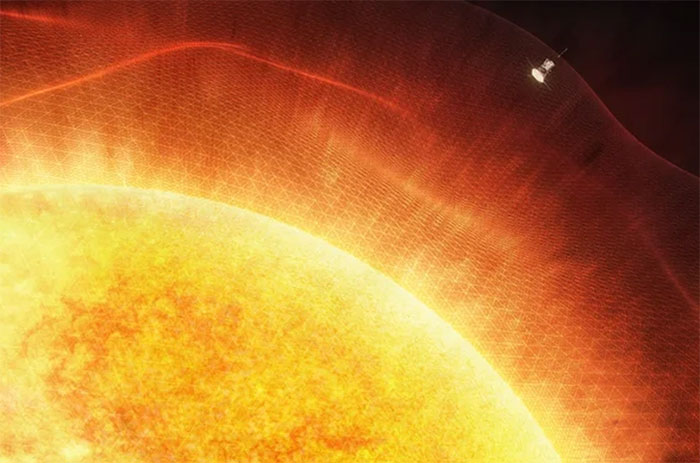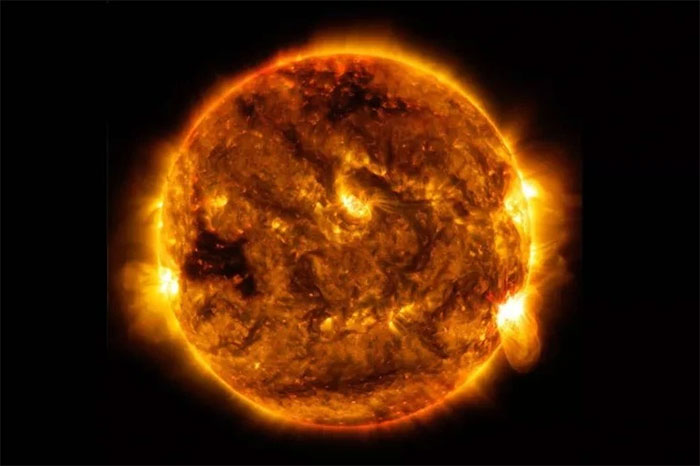Unknown solar waves defy all laws of physics
New discoveries of a type of wave called the HFR have challenged the fundamental laws of physics known to man until now, and hinted at possibilities we have not yet explored.

In April 2021, the Parker probe passed the boundary, entering the atmosphere of the Sun.
Recently, scientists have discovered a new type of high-frequency waves on the surface of the Sun. The strange thing is that this wave moves 3 times faster than what was found in previous studies
They call them high frequency reverse eddy waves (HFRs). These waves are detected when they move in the opposite direction of the Sun's rotation. The results of this study were described and published March 24 in the journal Nature Astronomy.
It is known that until now, scientists have not been able to uncover the mysteries deep inside the star at the center of the Solar System. So they often turn to measuring and calculating sound waves traveling across the surface, then reflected back to its core to figure out what's going on inside. But the unprecedented speed of HFR waves suggests that scientists may be missing out on something bigger.
"The existence of HFR waves and their origin is a real mystery and could allude to interesting physical phenomena going on," said co-author Shravan Hanasoge, an astrophysicist at China New York University's Center for Space Science, Abu Dhabi, said in a statement. "It could help us shed light on the unobservable 'inner world' of the Sun."
Scientists initially thought that solar sound waves formed near the surface thanks to the Coriolis effect. Accordingly, points on the equator of a spinning sphere seem to move faster than points located at the poles.

Image of the Sun from NASA's Solar Dynamics Observatory.
Once the waves form, scientists think there are three possibilities that can accelerate them, to become HFR waves. That's because the Sun's magnetic field, or its gravity, can spur Coriolis waves, or superheated convection currents moving below and above its surface formed in a special process.
However, these new waves do not seem to be the result of the above processes, as none of them are feasible, and consistent with the data. That has led to a whole new set of questions, surpassing the basic laws of physics known to man until now.
Filling in the "gaps" in humanity's knowledge could help researchers better understand the interior of the Sun, as well as better understand how the Sun affects the Earth and planets. other in the Solar System.
The scientists believe this knowledge could also provide insight into a similar type of high-frequency wave, known as a Rossby wave, that may have traveled four times faster through Earth's oceans times that of the current models that we can interpret.
- The 'spooky' slope makes the laws of physics completely overturned
- 6 magic tricks that challenge all the laws of physics in the world
- The scenes go against the laws of physics and still attract thousands of viewers
- Video: Challenge the god of death to prove Newton's law
- Dogs recognize when 3D objects violate Newton's laws of physics
- Explain fascinating waves with comics and cartoons
- 5 utopian phenomena can happen under a physical perspective
- Video: Simple test with balloons breaking the laws of physics
- Find a way to break the second law of thermodynamics
- Detected strange light waves never known
- New research direction from gravitational wave discovery won the Nobel Prize
- The most bizarre laws on the planet
 Vietnam 5th Asian champion on fuel-efficient vehicles
Vietnam 5th Asian champion on fuel-efficient vehicles We can read all NASA studies completely free of charge
We can read all NASA studies completely free of charge Singer and songwriter Bob Dylan won the 2016 Nobel Prize for Literature
Singer and songwriter Bob Dylan won the 2016 Nobel Prize for Literature Scientific revolution in Asia
Scientific revolution in Asia